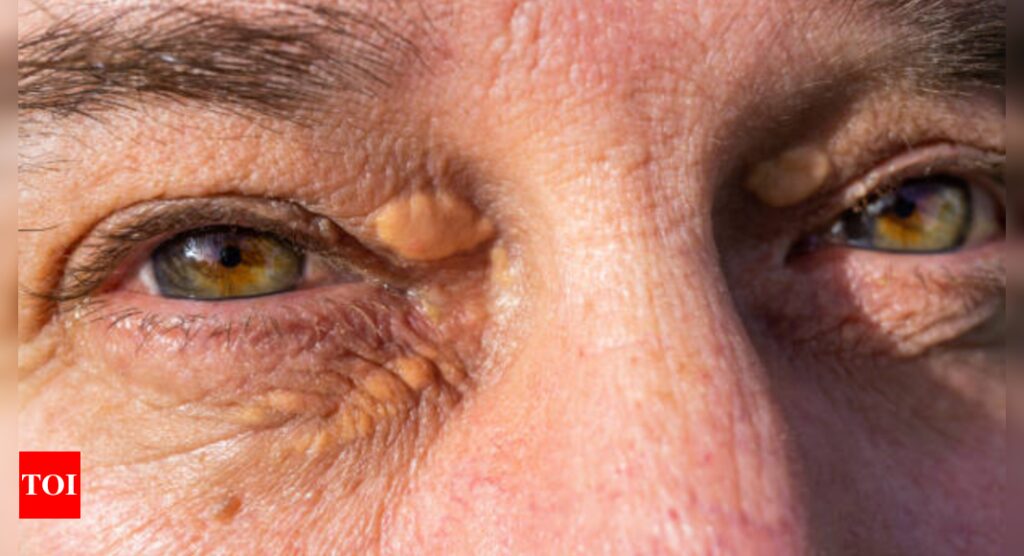Xanthelasma: Are eyelid bumps a hidden danger? Know what it means for the heart health |

Yellowish or flesh-colored bumps around the eyes are not only a cosmetic problem; sometimes they can be indicators toward health issues such as heart disease. These cholesterol-filled deposits, known medically as xanthelasma, appear around the eyes and act like markers for high cholesterol levels and potential cardiovascular disease.
Here’s a closer look at how these seemingly harmless skin growths around the eyes are linked to heart health:
Do you know about Xanthelasma?
Xanthelasma is a soft, yellowish plaque that appears on or around the eyelids. It is most common among middle-aged and older adults and may occur in people with high levels of low-density lipoprotein (LDL) cholesterol or triglycerides. These lipids, or fatty deposits, collect within the skin and cause these visible lumps. Even though they are painless and usually cause no discomfort in the body, their existence can be an indication of the collection of the same lipids elsewhere in the body, including within the arteries, leading to atherosclerosis, which is the major risk factor for heart diseases.
Studies show that xanthelasma is more than just a cosmetic issue. In fact, it is sometimes linked with an increased risk of heart disease. The patient who develops these deposits will more likely have a raised level of cholesterol. In turn, the deposit itself is an early marker for an imbalance of lipid levels. At high lipid levels, the effect on the blood vessels can be felt and observed even in the skin. The formation of plaque can lead to narrowing of the arteries and, consequently, to the limitation of blood supply to the heart, eventually resulting in coronary artery disease, heart attacks, or strokes.
“About 50% of people with xanthelasma have abnormal lipid levels (high LDL cholesterol, low HDL cholesterol or high triglyceride levels). Xanthelasma can also be seen in uncontrolled diabetes mellitus and inadequately treated hypothyroidism, which could be associated with abnormal lipid levels,” Dr Sudhir Kumar, had posted on X, few months back. “Xanthelasma is harmless and does not need treatment,” he added.
Xanthelasma is often associated with conditions that affect cholesterol metabolism, such as hypercholesterolemia and hyperlipidemia. Individuals with a family history of xanthelasma or heart disease may view these as red flags for their cardiac health.
Yellowish-colored bumps near the eyes is a condition that requires checking by a healthcare provider. High levels of cholesterol should be diagnosed earlier since proper management will prevent possible cardiovascular complications. Apart from cholesterol checks, blood pressure and blood glucose tests should be conducted to determine whether one’s cardiovascular health is impaired.
“There are several preventions that can be used to ensure heart health. Cholesterol level screenings, along with screenings for heart rhythm abnormalities, can identify a risk early. A lifestyle of heart health is promoted by a balanced diet in fruits, vegetables, and whole grains, and the need for regular exercise should be emphasized. Reducing stress and avoiding smoking can further help to reduce cardiovascular risk.,” says Dr. Parin Sangoi, Consultant Interventional Cardiologist at Wockhardt Hospitals Mumbai Central.
Lifestyle changes can greatly reduce cardiovascular risk in people diagnosed with xanthelasma and high cholesterol. Some of these include dietary changes, such as lowering saturated and trans fats and increasing fruits, vegetables, and whole grains, which help manage cholesterol levels. Exercise and weight management are also very effective. Cholesterol-lowering medications like statins may be prescribed in some cases. It can also be removed cosmetically by treatments such as laser, cryotherapy, or surgery, and it will likely recur unless cholesterol levels are reduced.
Although xanthelasma is benign and harmless in nature, it can be an indicator of cardiovascular risk. High cholesterol must be diagnosed and treated to prevent heart disease. The small, insignificant-looking bumps around the eyes should make people take steps in monitoring and managing their heart health, reducing the risk of worse outcomes like heart attacks or strokes.
5 Foods that will keep your skin hydrated this winter








